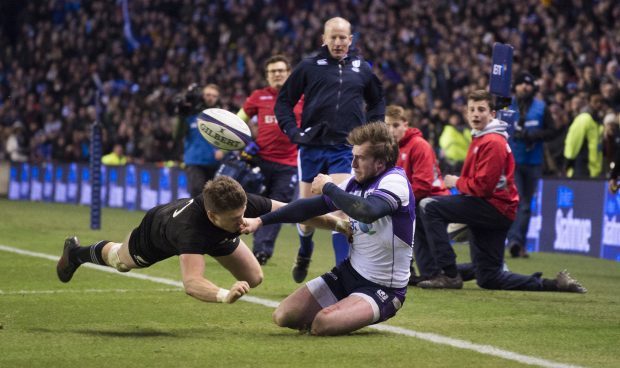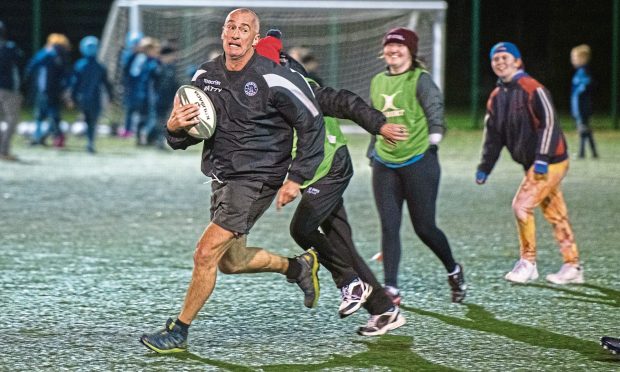It seems harsh in the circumstances – incredibly harsh – but the fact remains. Glorious failure is still failure.
For all the credit that the Scotland team deserve for the performance against New Zealand, for all the dogged, determined and – yes – brave effort underpinned with some superb skill and cool decision making, the All Blacks left with the win. A good deal more relieved than they thought they’d be, but just like the 31 previous matches over 112 years, the Scots couldn’t beat them.
It was undeniably an epic occasion. BT Murrayfield, swept on a tide of emotion from the off by the presence of Doddie Weir bringing on the match ball, rocked all afternoon like never before since redevelopment in 1991.
Stuart Hogg, slicing through all day with sometimes desperate All Blacks hanging to his shirt tail, was the symbolic figure of the match, and if he’d been able to slip past Beauden Barrett at the thrilling end of the contest they’d be singing his name at Murrayfield for the next 112 years.
They may still do; the full-back is still just 25, and there will be more chances to play New Zealand – possibly the next time could be the Rugby World Cup quarter-final in 2019, and what a time that would be to end this.
But as someone who is already three-quarters through his allotted three score years and ten, you wonder if this was the great chance at last to beat New Zealand and whether it will ever happen in your lifetime.
Because make no mistake the Scots should have won this game. There might be some who are relatively happy with avoiding the much predicted humiliation, but certainly not within the squad. There is pride at the performance, yes, but as Hogg – almost inconsolable that he hadn’t been able to lift Scotland to victory by his sheer force of will – said bluntly afterwards “if you’re not here to win, there’s the door.”
While the atmosphere and final drama will be remembered by most, we should also note some of the circumstances. The fact that New Zealand had 14 men for the entire final quarter of the match. The 17 – yes, 17 – times Scotland had possession inside the All Black 22.
Gregor Townsend revealed that stat after the game as if it was a virtue, and in some ways, yes, it was. But 17 possessions inside your opposition’s red zone, even given the tenacity and ferocity of the New Zealand defence, should surely return more than just two tries.
Scotland’s injury crisis in the front row – there are six frontline players out, so yes, it’s a crisis – came home to roost as we had feared. A relatively inexperienced New Zealand front row were on top for most of the game, and a seven man scrum stood up the Scots’ eight in the shadow of the New Zealand posts at a key point in the second half.
Scotland’s defence was all that had been promised during the week, and limiting the All Blacks to 22 points was really all Townsend and his coaching team could have hoped for. But they must have hoped to have made more of the attacking ball they had.
But there are signs of better to come, as Hogg made clear his belief afterwards. The pack was effectively patchwork, only John Barclay and Jonny Gray surviving from the Six Nations; some have made cases for moving up the ranks like Stuart McInally and Cornell du Preez, but Scotland’s strongest possible eight won’t ever come together in 2017; hopefully they will in 2018.
And the mentality of the team has changed. This was not an error-free performance – Tommy Seymour made more in the first half than he has in most recent seasons – but in Townsend’s slightly indelicate phrase they simply chose to “flush” the mistakes from their minds.
“The attitude was, so we’re defending a scrum on our five metre line rather than halfway, there’s a job to do, let’s do it,” said the head coach.
There were Barclay’s steals, and Ali Price pirating ball from the hands of Aaron Smith at the base of that five-metre scrum. The All Blacks, fresh from scoring five tries almost effortlessly in the first half in Paris a week before, were happy to reach the break this time level at 3-3 and that due to a marginal penalty as Barclay went to jackal more ball.
But even when New Zealand did inevitably score, the floodgates we’ve seen swing wide open in the past stayed shut. Finn Russell’s intercept as New Zealand went for a third try in matter of ten minutes helped, but even when the All Blacks peerlessly cut through for Barrett’s score to make it 22-10 with just seven minutes remaining, the Scots believed they could come back. And incredibly, they very nearly did.
That belief, illustrated also in the games against Ireland, Wales and Australia earlier in the year, is the really new element in this Scottish squad, and it’s survived the change in coaching team. It’s one of the hallmarks of the best teams like New Zealand, and it’ll be a vital weapon moving forward.


